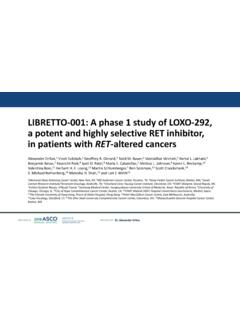Transcription of Understanding Clinical Trial Data Through Use of ...
1 Understanding Clinical Trial data Through Use of statistical GraphicsWill BushnellGroup Director GSK OncologyGlaxoSmithKlineA picture tells a thousand wordsLake BlancheA picture tells a thousand wordsOutline Introduction Patient Safety Exposure Laboratory data Hy s law AE relative risk Efficacy data Waterfall plots Skyline plots Forest plotsReview of safety data Safety data from Clinical trials is usually evaluated Through simple summary tables and review of individual patient data Formal analysis much less developed than for efficacy Scan tables and patient listings and highlight important results in textual summaries The safety of a molecule is best understood by Understanding data at the individual patient level Ideal opportunity to use graphical methods Present concise summaries Communicate main messages Increase efficiency of reviewExposure Before looking at safety we need to answer a key question:How many for how long and at what dose?
2 What is the exposure underlying the safety profile Tabular summaries are of Exposure187 Median7 Min 500 Max198 Mean225 NExposure(Days)Summary of ExposureA screening tool for AEsLab DataRoutine Summary Statistics for Liver Function2%25%Bilirubin(n=200)12%35%AST(n =200)15%40%ALT(n=200)Elevations > 3 XULNAny ElevationThis tabular summary does not tell the whole storyConsider a Simple GraphGraphical Style Graphical equivalent of a shift table Reference lines at clinically important levels Focus on upper left quadrant of each panel Position legend in unused part of graph with statement of numbers of patients May need legend for each panel to account for varying patient numbers Plot control group last to more readily identify Tx effect Consider displaying on log scale to account for skewed distributionSome Relevant Questions Do ALT and AST track together? Are there simultaneous elevations in ALT and Bilirubin?
3 Another Simple Scatter MatrixHy s Law Hy s Law was developed by Hyman Zimmerman as criteria for evaluating drug induced liver injury The signal for potential for severe drug-related hepatotoxicityhas three components: 1. Elevation of transaminases >3 ULN: ALT AST 2. Concomitant elevation of Bilirubin 3. Absence of other etiology Hy s Law could be evaluated as part of the scatter matrix by generating different symbols for subjects who meet the criteriaAnother version of the Scatter Matrix Some Hypothetical Data10^ ^ ^ ^ ^ ^ (xULN)ALT (xULN)AST (xULN) (xULN)AST (xULN)ALT (xULN)Patient ProfilesWaterfall Plot for Evaluating Changes from BaselineWaterfall plot showing best volumetric reduction of brain tumorsSubject20406080100120140160180200- 100050100150200250300350400450-20-50 Volumetric change from baseline, %0 Lin et al, ASCO 2007N=194 Independent-Reviewer Assessed Percent Reduction in Tumor Measurement at 12 Weeks From Baseline Hutson et al, ASCO 2007N=225 Graphical style of waterfall plot A method for looking at tumour shrinkage Can be adapted for other data Displays the distribution by looking at the order statistics Color and patterns to differentiate magnitude of changes Can display distributional location shifts in a comparative setting Beware if randomization is not 1.
4 1 Some examples from regulatory reviewA forest plot to make a pointHR= Plot, examination of time course of hazard ratioFrom FDA statistical review summary of LapatinibSummary and Conclusions Lake Blanche on Sunday Exposure critical first step in safety analysis Evaluation of patient safety from Clinical trials summary stats alone of limited value graphics must provide identification of outliers careful examination of individual patient data Waterfall plots valuable for change data Skyline plots indicate the maturityof an estimateAcknowledgements The graphics were developed by a team in the Biostatistics Division of GSK:Frank ManinoPeter LaneRandall AustinNada BoudiafMike ColopySusan DukeRich HeibergerGurudutt LingashastryDaniel LorandDaniel ParkShi-Tao YehMichael DuranteTheresa CroftsMichelle , HJ, 1978, Drug-Induced Liver Disease, In: Hepatotoxicity, The Adverse Effects of Drugs and Other Chemicals on the Liver, 1st ed.
5 , pp. 351-3, Appleton-Century-Crofts, New York. MJ, Eisen T, Stadler WM, et al. Phase II placebo-controlled randomized discontinuation Trial of sorafenib in patients with metastatic renal cell carcinoma. J Clin Oncol 2006;24:2505-2512 Di Leo, H. Gomez, Z. Aziz, Z. Zvirbule, M. Arbushites,M. Koehler, L. S. Williams, J. Dering,R. S. Finn,Lapatinib With Paclitaxel Versus Paclitaxel as First-Line Treatment for Patients With Metastatic Breast Cancer: A Phase III Randomized, Double-blind Study in 580 Patients, ASCO, (GW786034) is active in metastatic renal cell carcinoma (RCC): Interim results of a phase II randomised discontinuation Trial (RDT). TE Hutson, ID Davis, JP Machiels, PL deSouza, BF Hong, S Rottey, KL Baker, T Crofts, L Pandidte, R Figlin. ASCO 20007





